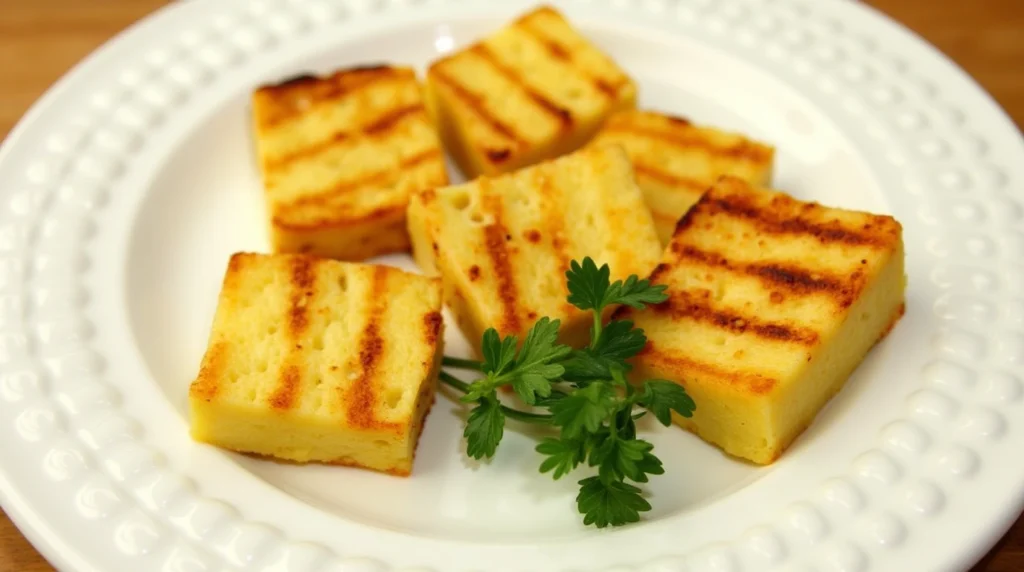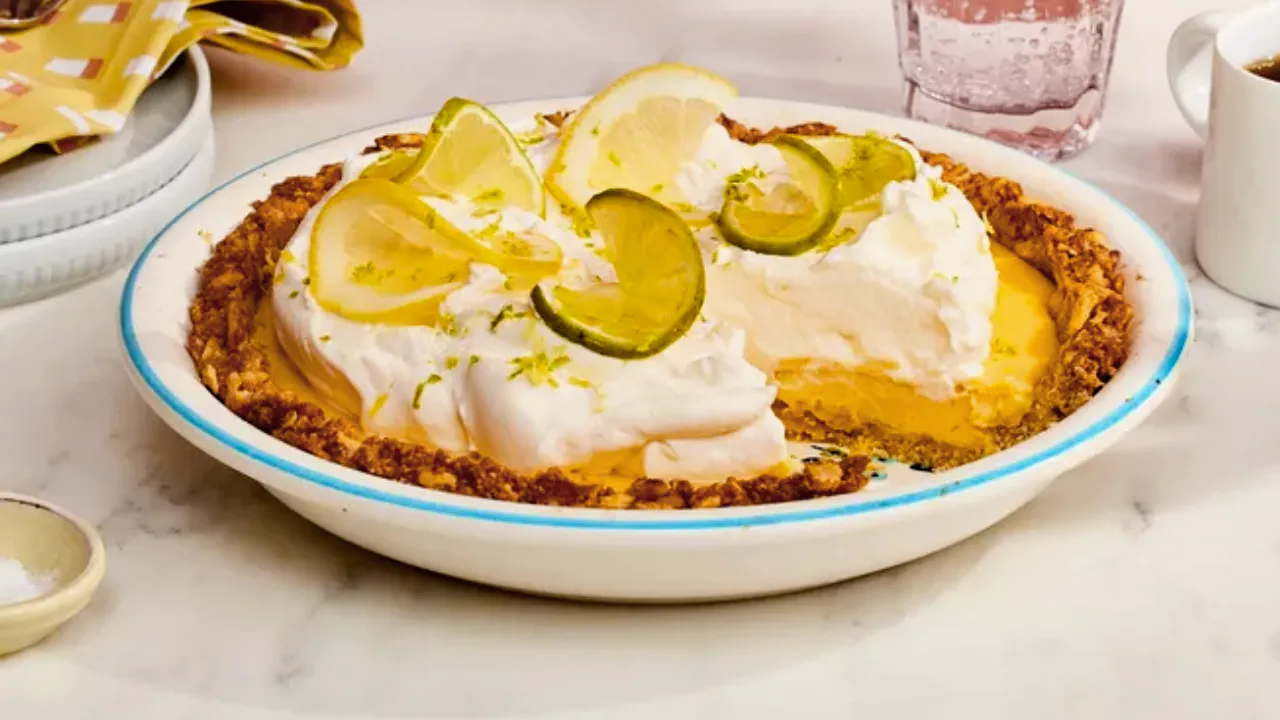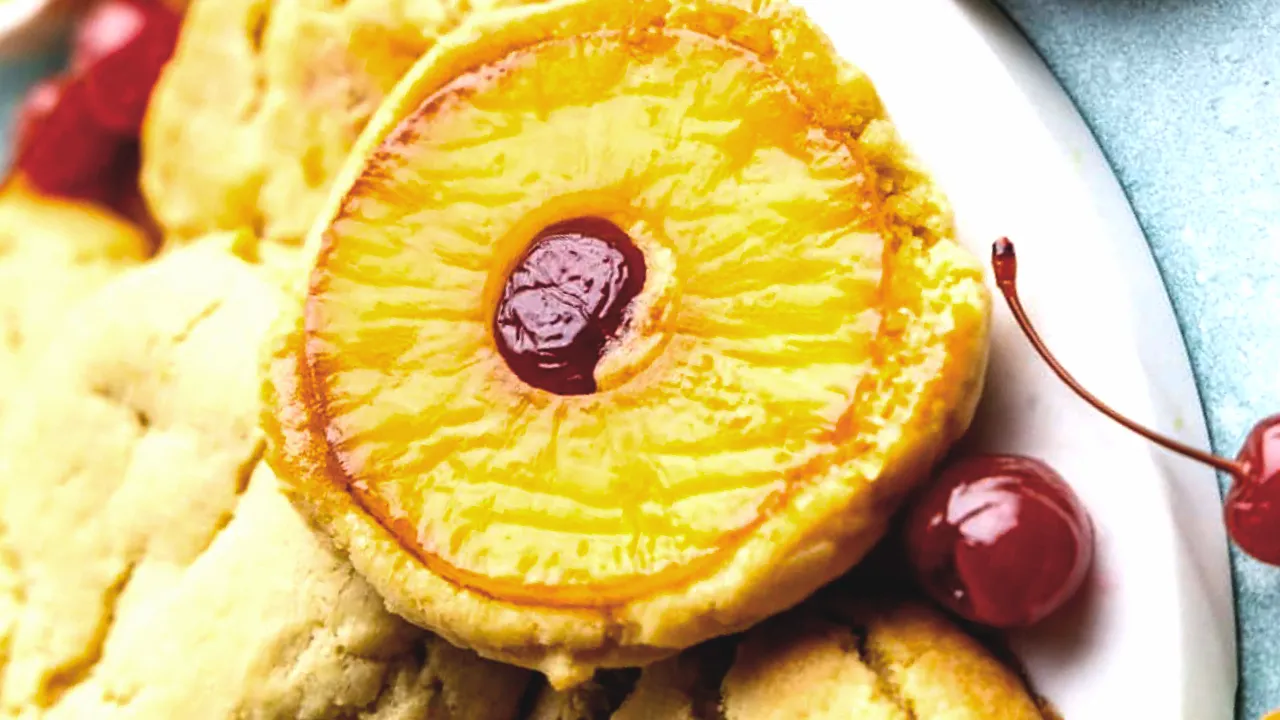Grilled halloumi cheese is a delicious and versatile cheese that has gained global popularity for its ability to hold its shape when heated. But what is grilled halloumi cheese made of, and what makes it so unique? Known as the “cheese that grills,” halloumi is loved for its salty flavor, chewy texture, and ability to add protein-packed goodness to salads, sandwiches, or even enjoyed on its own.
In this guide, we’ll explore what halloumi cheese is made of, its unique qualities, and why it performs so well when grilled. Whether you’re a halloumi lover or just discovering it, you’ll learn everything about this beloved cheese and how to prepare it perfectly.
What is Halloumi Cheese?
Halloumi is a semi-hard, brined cheese originating from the Mediterranean island of Cyprus. Known for its salty flavor, firm texture, and high melting point, it has become a global favorite, particularly for grilling and frying. Unlike many other cheeses, halloumi doesn’t melt when exposed to heat, making it ideal for cooking while retaining its shape.
The Origin and History of Halloumi
Halloumi has a rich history dating back to the Byzantine period (around AD 395–1191). It was traditionally produced in Cyprus as a staple food among farmers and shepherds. The cheese became popular across the Mediterranean due to its long shelf life, as it can be preserved in brine for extended periods without refrigeration.
Today, halloumi is not only a Cypriot culinary treasure but also widely enjoyed in Europe, the Middle East, and beyond, where it’s celebrated for its versatility.
The Unique Qualities of Halloumi
- Firm and Springy Texture
- Halloumi’s structure allows it to hold its shape when grilled, fried, or baked.
- Salty and Tangy Flavor
- The brining process gives halloumi its signature salty taste, which pairs beautifully with sweet and savory dishes.
- High Melting Point
- Unlike most cheeses, halloumi does not melt at high temperatures, making it perfect for grilling or frying.
What is Grilled Halloumi Cheese Made Of?
Key Ingredients in Griilled Halloumi Cheese
Grilled halloumi consists of a simple combination of natural ingredients that give it its firm texture and unique flavor.
Milk
Producers traditionally use a blend of sheep’s milk and goat’s milk to make halloumi. These types of milk contribute to its rich, slightly tangy flavor. In modern production, many manufacturers add cow’s milk or use it as a substitute, especially for commercial varieties, to make the process more cost-effective.
Rennet
Rennet plays a crucial role in halloumi production by curdling the milk and separating the curds (solids) from the whey (liquid). While traditional halloumi relies on animal-based rennet, some manufacturers now use microbial or plant-based rennet to produce vegetarian-friendly versions of the cheese.
Salt
Producers preserve halloumi in a salt brine, which infuses the cheese with its signature salty taste. The brine also extends the cheese’s shelf life and enhances its firm texture, allowing it to withstand grilling or frying without melting.
Mint Leaves (Optional)
In traditional recipes, producers fold fresh or dried mint leaves into the cheese during production. The mint not only adds a subtle herbal flavor but also acts as a natural preservative.
By using quality ingredients and time-honored techniques, halloumi achieves its characteristic flavor and ability to hold its shape under high heat.
The Process of Making Halloumi Cheese
The production of halloumi is straightforward and focuses on its unique high melting point:
- Heating the Milk
- The milk is heated gently and curdled with rennet. The curds are cut and stirred to help expel whey.
- Forming the Cheese
- The curds are drained, pressed into blocks, and poached in whey to solidify the structure.
- Salting and Brining
- The cheese is sprinkled with salt and soaked in brine, which preserves it and enhances its flavor.
- Optional Addition of Mint
- Traditionally, mint is added between layers of cheese or mixed into the curds for extra flavor.
Why These Ingredients Matter
The combination of milk, rennet, and brine is what gives halloumi its distinct texture and salty, tangy flavor. The high protein content and moisture level make it ideal for grilling, as it browns beautifully while remaining chewy inside.
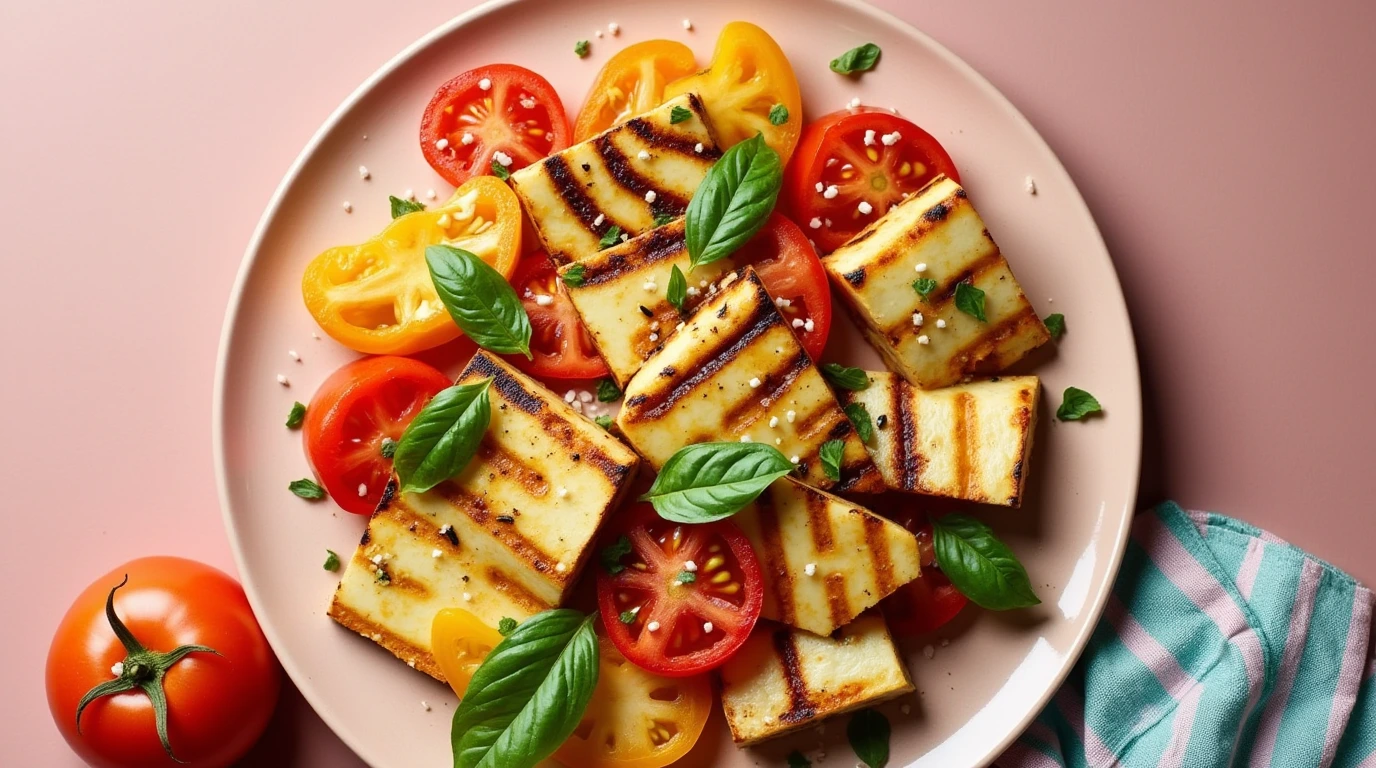
Why Does Halloumi Grill So Well?
The Science Behind Its High Melting Point
One of halloumi’s defining characteristics is its ability to hold its shape under high heat, making it perfect for grilling or frying. Here’s why:
- Low Acid Content
- Unlike other cheeses, halloumi is made with minimal acid development during the cheese-making process.
- Lower acidity prevents the proteins in the cheese from breaking down easily when heated, keeping the structure intact.
- High Protein Content
- The high protein content in halloumi creates a network that holds moisture while allowing the surface to caramelize without melting.
- Brining Process
- Soaking the cheese in salt brine helps it develop a firm texture and a slightly chewy consistency, making it heat-resistant.
Texture and Flavor of Grilled Halloumi Cheesei
When grilled, halloumi transforms beautifully:
- Golden Crust: The surface develops a crispy, golden-brown crust that adds a layer of texture.
- Soft, Chewy Center: Inside, the cheese remains tender and chewy, offering a delightful contrast to the crispy exterior.
- Flavor: Grilling enhances halloumi’s naturally salty and tangy flavors while adding a subtle smokiness.
Why Grilled Halloumi Cheese is Perfect
- Unlike soft cheeses such as mozzarella or brie, halloumi doesn’t melt or lose shape.
- It’s easy to handle on the grill, requiring minimal preparation and cooking time.
- Grilled halloumi pairs well with a variety of flavors, both sweet and savory, making it a versatile addition to meals.
Grilled Halloumi Cheese: Step-by-Step Guide
Preparing and Grilled Halloumi Cheese
Grilled Halloumi Cheese is easy to make and requires minimal preparation. Follow these steps to achieve perfectly golden and crispy halloumi every time.
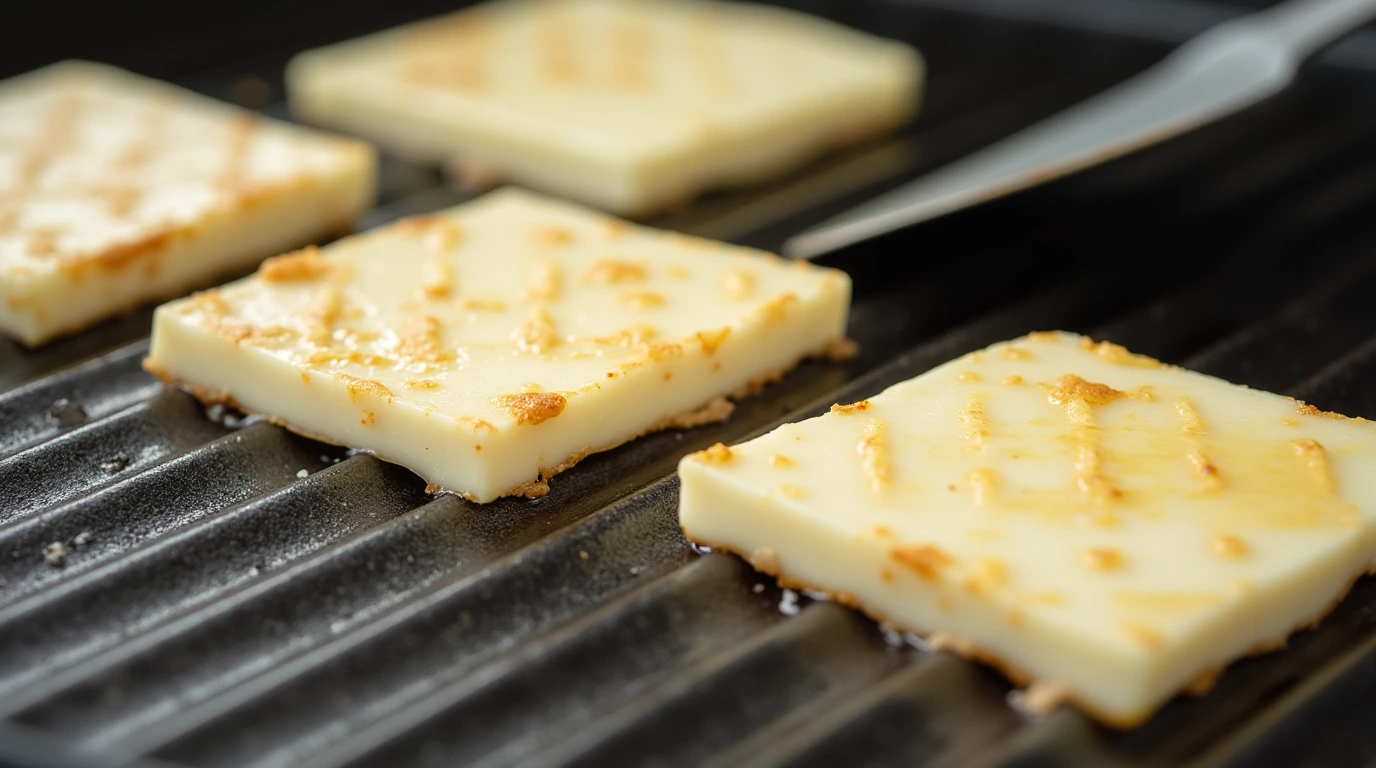
1: Preparing the Cheese
- Slice the Halloumi
- Cut the halloumi into slices about ¼ to ½ inch thick. Thicker slices hold their shape better during grilling.
- Pat It Dry
- Use a paper towel to gently pat the slices dry. This helps reduce excess moisture and allows for a crispier surface when grilled.
- Optional Seasoning
- Halloumi has a natural salty flavor, but you can enhance it with seasonings like:
- A drizzle of olive oil
- A sprinkle of black pepper or smoked paprika
- Fresh herbs like thyme or oregano
- Halloumi has a natural salty flavor, but you can enhance it with seasonings like:
2: Grilled Halloumi Cheese
- Preheat the Grill or Pan
- Use a grill, grill pan, or non-stick skillet. Heat it over medium-high heat. If using a BBQ, oil the grates lightly to prevent sticking.
- Place the Halloumi Slices
- Lay the slices on the hot surface. Grill for about 2-3 minutes per side until golden brown grill marks form.
- Flip and Cook the Other Side
- Use tongs or a spatula to gently flip the halloumi. Grill for another 2-3 minutes until both sides are crispy and golden.
3: Serving Grilled Halloumi Cheese
- Rest for a Moment
- Allow the grilled halloumi to cool slightly before serving to let the flavors settle.
- Serve Immediately
- Halloumi is best enjoyed warm while it’s crispy on the outside and soft inside.
Pro Tips for Perfect Grilled Halloumi Cheese
- Don’t Overcook: Cooking for too long can make halloumi rubbery instead of tender. Stick to 2-3 minutes per side.
- Use Medium-High Heat: Halloumi browns better at high heat without melting.
- Avoid Excess Salt: Since halloumi is naturally salty, go easy on additional salt.
Ways to Enjoy Grilled Halloumi Cheese
1. As a Main Dish or Appetizer
Grilled halloumi can shine on its own as the centerpiece of a meal or as a crowd-pleasing starter.
- Halloumi Skewers: Thread grilled halloumi onto skewers with cherry tomatoes, zucchini, and bell peppers for a colorful and flavorful dish.
- Halloumi Platter: Serve with a side of olives, roasted red peppers, and pita bread for a Mediterranean-inspired appetizer.
Pro Tip: Drizzle with honey or balsamic glaze for a sweet-savory twist.
2. In Salads
Grilled halloumi adds a rich and salty flavor that pairs beautifully with fresh greens and vegetables.
- Halloumi and Arugula Salad: Combine grilled halloumi slices with arugula, cherry tomatoes, cucumber, and a lemon-olive oil dressing.
- Grilled Halloumi Cheese and Watermelon Salad: Pair the salty halloumi with juicy watermelon, mint, and a drizzle of lime juice for a refreshing summer dish.
Pro Tip: Add toasted nuts or seeds for an extra crunch.
3. In Sandwiches and Wraps
Grilled halloumi makes a fantastic meat alternative in sandwiches and wraps.
- Halloumi Sandwich: Layer grilled halloumi with avocado, tomatoes, lettuce, and a creamy garlic sauce in toasted ciabatta bread.
- Mediterranean Wrap: Stuff warm pita bread with grilled halloumi, hummus, roasted vegetables, and fresh spinach for a satisfying wrap.
Pro Tip: Use tzatziki sauce or harissa for added flavor.
4. Pairing Ideas for Grilled Halloumi Cheese
Grilled halloumi pairs well with both sweet and savory flavors:
- Sweet Pairings: Serve with fruits like figs, pears, or grapes. A drizzle of honey enhances the cheese’s salty notes.
- Savory Pairings: Pair with roasted vegetables, quinoa, or grain salads for a hearty meal.
Perfect for Brunch: Combine grilled halloumi with poached eggs, avocado, and sautéed spinach for a protein-packed brunch.
FAQs About Grilled Halloumi Cheese
1. Is Halloumi Vegetarian-Friendly?
Yes, halloumi can be vegetarian-friendly depending on how it’s made. Traditional halloumi uses animal-derived rennet to curdle the milk, but many modern versions use vegetarian rennet. Always check the label to ensure it’s suitable for vegetarians.
2. What Are the Best Alternatives to Halloumi?
If you don’t have halloumi on hand, try these alternatives that work well for grilling:
- Paneer: A fresh Indian cheese that grills similarly and holds its shape.
- Queso Fresco: A mild Mexican cheese with a firm texture.
- Feta (Firm Block): Can be grilled if handled gently; it provides a slightly tangier flavor.
3. How Do You Store Leftover Grilled Halloumi Cheese?
- Refrigerate: Store leftover grilled halloumi in an airtight container for up to 3 days.
- Reheat: Warm it in a skillet over medium heat for 1-2 minutes per side or in an oven at 350°F (175°C). Avoid microwaving, as it can alter the texture.
4. Can You Freeze Halloumi?
Yes, you can freeze halloumi before or after grilling:
- Before Grilling: Wrap it tightly in plastic wrap and store it in a freezer bag. Thaw in the refrigerator before grilling.
- After Grilling: Freeze in an airtight container and reheat as needed.
5. Why is Halloumi So Salty?
Halloumi is preserved in a salt brine during production, which extends its shelf life and enhances its flavor. To reduce saltiness, rinse the cheese under cold water or soak it in fresh water for 10-15 minutes before grilling.
Internal Link Integration
For more halloumi inspiration, check out our grilled halloumi recipe for step-by-step tips and serving ideas.
Conclusion
Grilled Halloumi Cheese is a versatile and delicious cheese that stands out for its unique ability to hold its shape when cooked. With its salty, tangy flavor and satisfying chewy texture, it has become a favorite in kitchens around the world. Whether served on its own, in salads, wraps, or paired with sweet and savory ingredients, grilled halloumi offers endless possibilities for creative and flavorful meals.
Understanding the ingredients of grilled halloumi—a simple mix of milk, rennet, and salt—explains its enduring popularity in Mediterranean cuisine for centuries. By perfecting your grilling skills and experimenting with creative pairings, you can savor this versatile cheese in endless delicious ways.
For more detailed tips and inspiration, check out our ultimate grilled halloumi guide.

